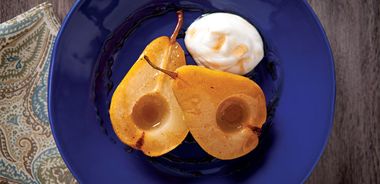Perfect Sweet Wine Winter Pears

4 firm pears such as Anjou
1 Tbsp (15 mL) unsalted butter, at room temperature
2 Tbsp (30 mL) liquid honey
1/2 tsp (2 mL) cinnamon
Freshly grated nutmeg
3/4 cup (180 mL) sweet white wine such as Muscat or Viognier
1/4 cup (60 mL) crème fraîche
Preheat oven to 375 F (190 C).
Peel pears, cut in half, and core using melon baller or sharp paring knife. Generously butter a 13 x 9 x 2 in (3.5 L) baking dish with butter. Place pears cut side down in single layer in pan.
Warm honey and drizzle equal amounts over each pear half. Sprinkle with cinnamon and nutmeg. Pour sweet wine around pears. Bake for 40 minutes. Then generously baste with pan juices and continue to bake until pears are glazed and really tender but still holding their shape, about 10 to 15 minutes. Turn off oven and leave pears in pan in their juices in oven until ready to serve.
Alternately, remove pan from oven and keep pears in pan on cooling rack. If liquid has evaporated, add a little more wine just to keep them from drying out.
To serve, place a pear half or two on dessert dish. Place a spoonful of crème fraîche beside and drizzle with some of the pan juices.
Serves 4 to 8.
Each pear half contains: 132 calories; 1 g protein; 4 g total fat (3 g sat. fat, 0 g trans fat); 21 g total carbohydrates (15 g sugars, 3 g fibre); 5 mg sodium
source: "Cooking With Wine", alive #376, February 2014





